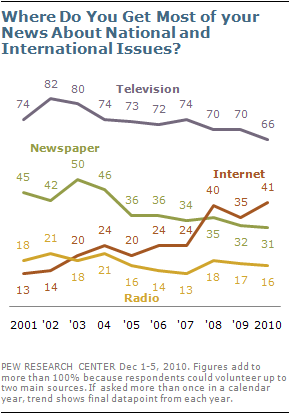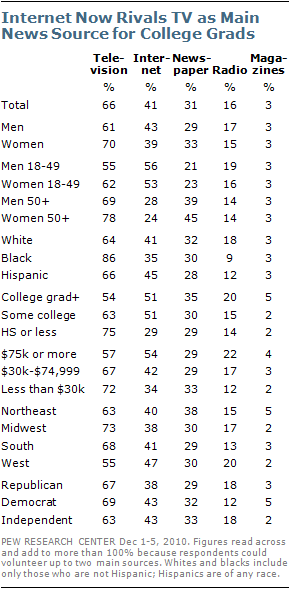 THUNDER BAY – Special to NNL – The internet is slowly closing in on television as Americans’ main source of national and international news. Currently, 41% say they get most of their news about national and international news from the internet, which is little changed over the past two years but up 17 points since 2007. Television remains the most widely used source for national and international news — 66% of Americans say it is their main source of news — but that is down from 74% three years ago and 82% as recently as 2002.
THUNDER BAY – Special to NNL – The internet is slowly closing in on television as Americans’ main source of national and international news. Currently, 41% say they get most of their news about national and international news from the internet, which is little changed over the past two years but up 17 points since 2007. Television remains the most widely used source for national and international news — 66% of Americans say it is their main source of news — but that is down from 74% three years ago and 82% as recently as 2002.
The national survey by the Pew Research Center for the People & the Press, conducted Dec. 1-5, 2010, among 1,500 adults reached on cell phones and landlines, finds that more people continue to cite the internet than newspapers as their main source of news, reflecting both the growth of the internet, and the gradual decline in newspaper readership (from 34% in 2007 to 31% now). The proportion citing radio as their main source of national and international news has remained relatively stable in recent years; currently, 16% say it is their main source.
 An analysis of how different generations are getting their news suggests that these trends are likely to continue. In 2010, for the first time, the internet has surpassed television as the main source of national and international news for people younger than age 30. Since 2007, the number of 18 to 29 year olds citing the internet as their main source has nearly doubled, from 34% to 65%. Over this period, the number of young people citing television as their main news source has dropped from 68% to 52%.
An analysis of how different generations are getting their news suggests that these trends are likely to continue. In 2010, for the first time, the internet has surpassed television as the main source of national and international news for people younger than age 30. Since 2007, the number of 18 to 29 year olds citing the internet as their main source has nearly doubled, from 34% to 65%. Over this period, the number of young people citing television as their main news source has dropped from 68% to 52%.
Among those ages 30 to 49, the internet is on track to equal, or perhaps surpass, television as the main source of national and international news within the next few years. Currently, 48% say the internet is their main source — up 16 points from 2007 — and 63% cite television — down eight points.
The internet also has grown as a news source for people ages 50 to 64; currently 34% say the internet is their main source of national and international news, nearly equal to the number who cite newspapers (38%), though still far below television (71%). There has been relatively little change in the how people ages 65 and older get their news. The internet has risen to 14% from 5% in 2007, but is still far behind newspapers (47%) and television (79%) as a main source.
The decline in the share of Americans who cite television as their main source of national and international news crosses all age groups. Over the past three years, the number saying TV is their main source has fallen 16 points among 18-29 year-olds, eight points among those ages 30 to 49, and six points among those ages 50 and older.
TV News Still Dominates Among Less Educated
College graduates are about as likely to get most of their national and international news from the internet (51%) as television (54%). Those with some college education are just as likely as college grads to cite the internet as their main source (51%), while 63% cite television. By contrast, just 29% of those with no more than a high school education cite the internet while more than twice as many (75%) cite television.
 Similarly, those with household incomes of $75,000 or more are about as likely to get most of their news on the internet (54%) as from television (57%). People with household incomes under $30,000 are far more likely to cite television (72%) than the internet (34%).
Similarly, those with household incomes of $75,000 or more are about as likely to get most of their news on the internet (54%) as from television (57%). People with household incomes under $30,000 are far more likely to cite television (72%) than the internet (34%).
There also are different patterns of news consumption across regions of the country. Notably, people living in the West are the most likely to cite the internet as their main source of national and international news (47% vs. 40% in other parts of the country), and the least likely to cite television (55% vs. 68% elsewhere).
Both Cable News and Broadcast News See Declines
Reflecting the slow decline in the proportion of people getting most of their national and international news from television, the numbers specifically citing cable news outlets or broadcast networks as their main news source has fallen. When asked where on television they get most of their news, 36% name a cable network such as CNN, the Fox News Channel or MSNBC; 22% name ABC News, CBS News or NBC News; and 16% say they get most of their national and international news from local news programming.
Compared with five years ago, the share citing a cable network as their main source is down seven points (from 43% to 36%), and the share citing a broadcast network is down eight points (from 30% to 22%). The local news figure has remained relatively constant over this period.
The Pew Research Center is a nonpartisan “fact tank” that provides information on the issues, attitudes and trends shaping America and the world. It does so by conducting public opinion polling and social science research; by analyzing news coverage; and by holding forums and briefings. It does not take positions on policy issues.
So, what might this mean? The figures are from the United States, which demographically is similar to Canada. As the readership of newspapers fall in the United States, that will likely continue to impact the pulp and paper industry in Canada and in Thunder Bay.
The changes in viewing habits are going to place greater pressure on smaller broadcasters in both radio, and television markets. Consumers are spending less time invested in listening to radio, and watching broadcast television. Radio’s numbers have remained fairly static over the reported time frame in the United States. However not factored in is the growing popularity of Ipods, Itouch, the Ipad and MP3 players.
Students and younger consumers have embraced Facebook, Youtube and downloaded music. In Canada, the move into streaming movies on services like Netflix are likely fitting in to the pattern for youth. The price is affordable, and the entertainment is instant.
The technology is moving extremely quickly. Growth and acceptance of new technology continues. The MacIntosh Ipad has the potential to change the computer market as it could move people from netbooks and laptops to the stylish tablet.
For the Thunder Bay region, the continued shift from paper to electronics for entertainment do not mean the end of the world of paper, but likely that it will be new products rather than traditional products that should be the focus for the industry.
